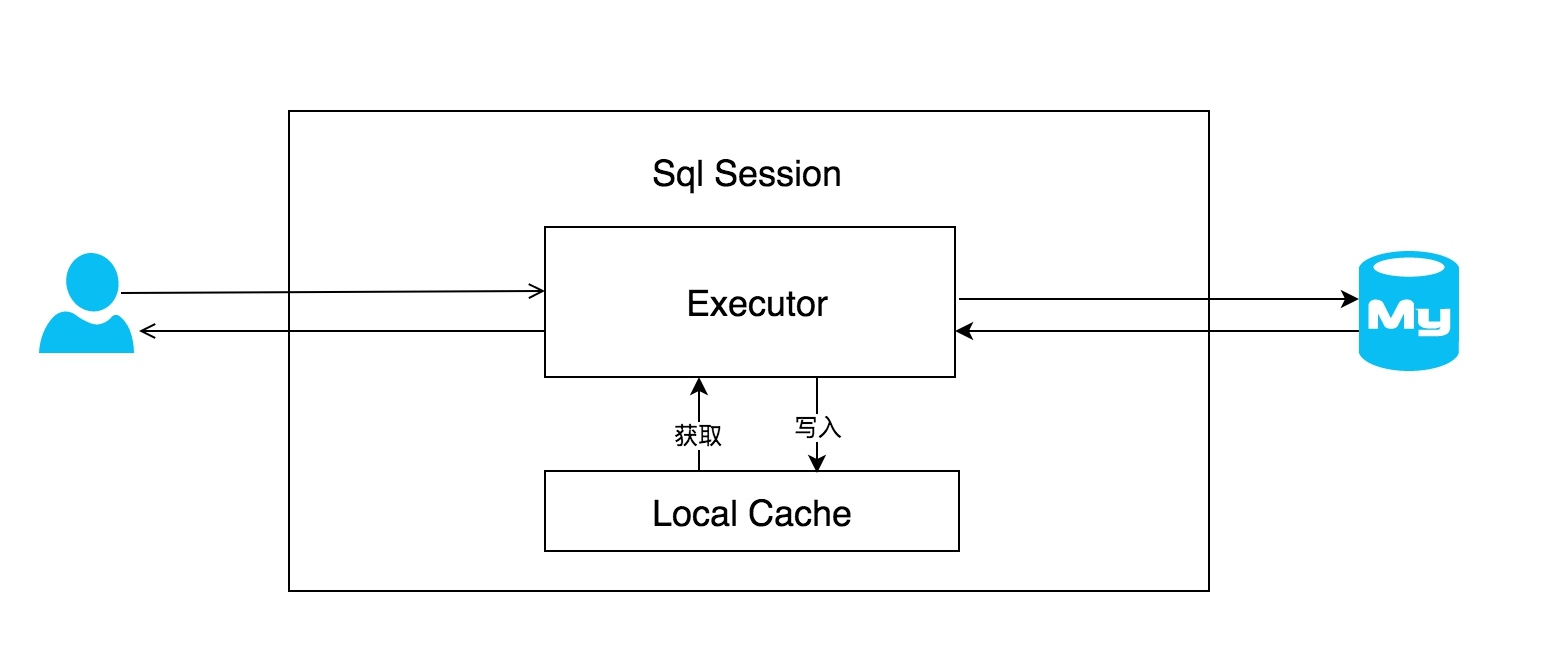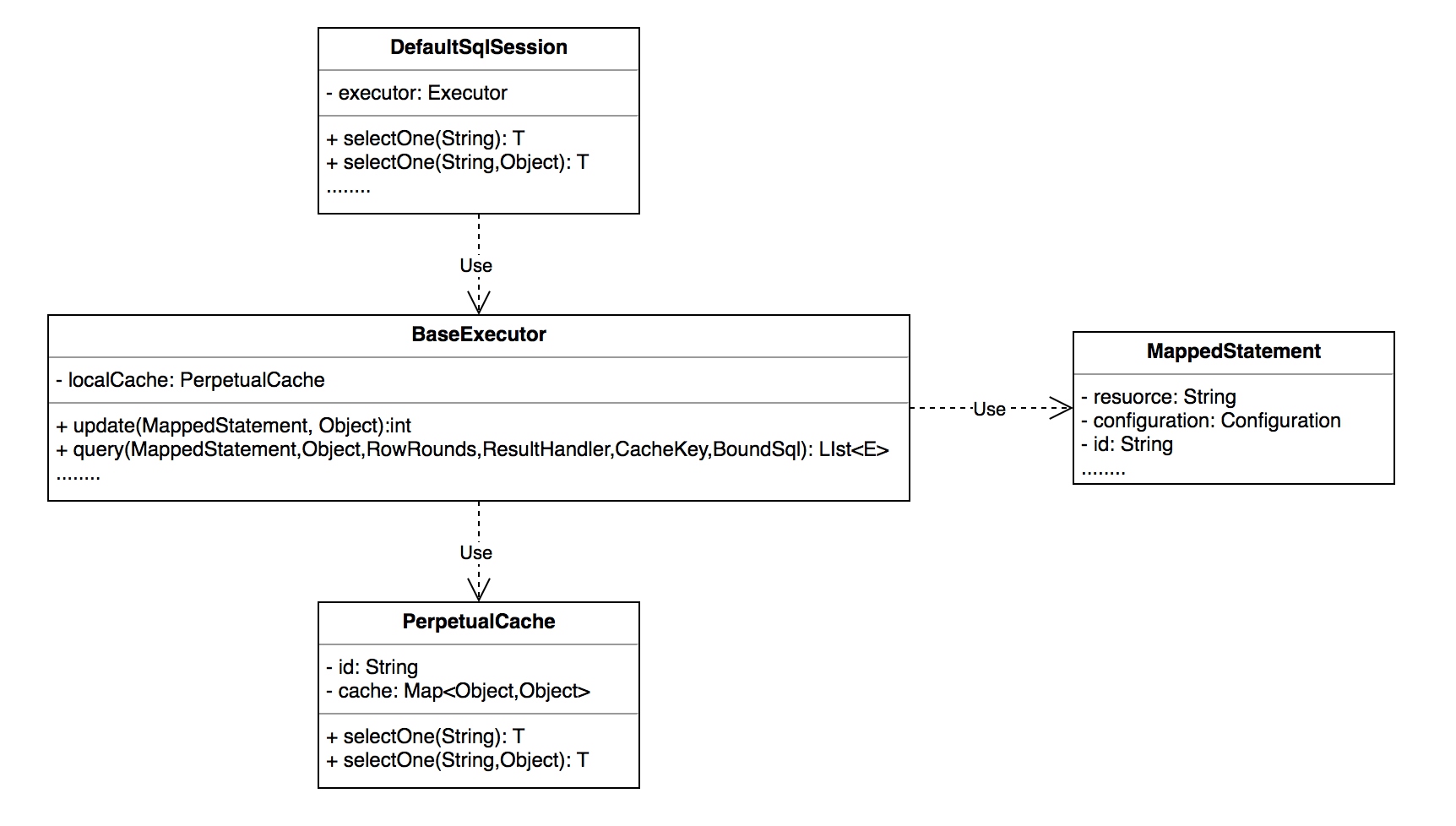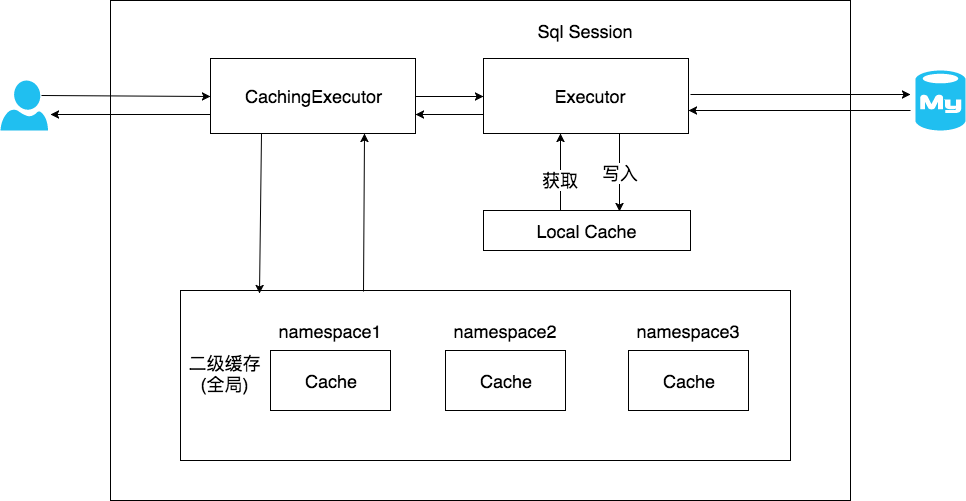一级缓存
一级缓存介绍
在应用运行过程中,我们有可能在一次数据库会话中,执行多次查询条件完全相同的SQL,MyBatis提供了一级缓存的方案优化这部分场景,如果是相同的SQL语句,会优先命中一级缓存,避免直接对数据库进行查询,提高性能。具体执行过程如下图所示。

每个SqlSession中持有了Executor,每个Executor中有一个LocalCache。当用户发起查询时,MyBatis根据当前执行的语句生成MappedStatement,在Local Cache进行查询,如果缓存命中的话,直接返回结果给用户,如果缓存没有命中的话,查询数据库,结果写入Local Cache,最后返回结果给用户。具体实现类的类关系图如下图所示。

一级缓存配置
我们来看看如何使用MyBatis一级缓存。开发者只需在MyBatis的配置文件中,添加如下语句,就可以使用一级缓存。共有两个选项,SESSION或者STATEMENT,默认是SESSION级别,即在一个MyBatis会话中执行的所有语句,都会共享这一个缓存。一种是STATEMENT级别,可以理解为缓存只对当前执行的这一个Statement有效。
<setting name="localCacheScope" value="SESSION"/>
一级缓存的范围有SESSION和STATEMENT两种,默认是SESSION,如果不想使用一级缓存,可以把一级缓存的范围指定为STATEMENT,这样每次执行完一个Mapper中的语句后都会将一级缓存清除。
当Mybatis整合Spring后,直接通过Spring注入Mapper的形式,如果不是在同一个事务中每个Mapper的每次查询操作都对应一个全新的SqlSession实例,这个时候就不会有一级缓存的命中,但是在同一个事务中时共用的是同一个SqlSession。
一级缓存实验
接下来通过实验,了解MyBatis一级缓存的效果,每个单元测试后都请恢复被修改的数据。
首先是创建示例表student,创建对应的POJO类和增改的方法,具体可以在entity包和mapper包中查看。
CREATE TABLE `student` (
`id` int(11) unsigned NOT NULL AUTO_INCREMENT,
`name` varchar(200) COLLATE utf8_bin DEFAULT NULL,
`age` tinyint(3) unsigned DEFAULT NULL,
PRIMARY KEY (`id`)
) ENGINE=InnoDB AUTO_INCREMENT=4 DEFAULT CHARSET=utf8 COLLATE=utf8_bin;
在以下实验中,id为1的学生名称是凯伦。
实验1
开启一级缓存,范围为会话级别,调用三次getStudentById,代码如下所示:
public void getStudentById() throws Exception {
SqlSession sqlSession = factory.openSession(true); // 自动提交事务
StudentMapper studentMapper = sqlSession.getMapper(StudentMapper.class);
System.out.println(studentMapper.getStudentById(1));
System.out.println(studentMapper.getStudentById(1));
System.out.println(studentMapper.getStudentById(1));
}
执行结果:

我们可以看到,只有第一次真正查询了数据库,后续的查询使用了一级缓存。
实验2
增加了对数据库的修改操作,验证在一次数据库会话中,如果对数据库发生了修改操作,一级缓存是否会失效。
@Test
public void addStudent() throws Exception {
SqlSession sqlSession = factory.openSession(true); // 自动提交事务
StudentMapper studentMapper = sqlSession.getMapper(StudentMapper.class);
System.out.println(studentMapper.getStudentById(1));
System.out.println("增加了" + studentMapper.addStudent(buildStudent()) + "个学生");
System.out.println(studentMapper.getStudentById(1));
sqlSession.close();
}
执行结果:

我们可以看到,在修改操作后执行的相同查询,查询了数据库,一级缓存失效。
实验3
开启两个SqlSession,在sqlSession1中查询数据,使一级缓存生效,在sqlSession2中更新数据库,验证一级缓存只在数据库会话内部共享。
@Test
public void testLocalCacheScope() throws Exception {
SqlSession sqlSession1 = factory.openSession(true);
SqlSession sqlSession2 = factory.openSession(true);
StudentMapper studentMapper = sqlSession1.getMapper(StudentMapper.class);
StudentMapper studentMapper2 = sqlSession2.getMapper(StudentMapper.class);
System.out.println("studentMapper读取数据: " + studentMapper.getStudentById(1));
System.out.println("studentMapper读取数据: " + studentMapper.getStudentById(1));
System.out.println("studentMapper2更新了" + studentMapper2.updateStudentName("小岑",1) + "个学生的数据");
System.out.println("studentMapper读取数据: " + studentMapper.getStudentById(1));
System.out.println("studentMapper2读取数据: " + studentMapper2.getStudentById(1));
}

sqlSession2更新了id为1的学生的姓名,从凯伦改为了小岑,但session1之后的查询中,id为1的学生的名字还是凯伦,出现了脏数据,也证明了之前的设想,一级缓存只在数据库会话内部共享。
总结
- MyBatis一级缓存的生命周期和SqlSession一致。
- MyBatis一级缓存内部设计简单,只是一个没有容量限定的HashMap,在缓存的功能性上有所欠缺。
- MyBatis的一级缓存最大范围是SqlSession内部,有多个SqlSession或者分布式的环境下,数据库写操作会引起脏数据,建议设定缓存级别为Statement。
二级缓存
二级缓存介绍
在上文中提到的一级缓存中,其最大的共享范围就是一个SqlSession内部,如果多个SqlSession之间需要共享缓存,则需要使用到二级缓存。开启二级缓存后,会使用CachingExecutor装饰Executor,进入一级缓存的查询流程前,先在CachingExecutor进行二级缓存的查询,具体的工作流程如下所示。

二级缓存开启后,同一个namespace下的所有操作语句,都影响着同一个Cache,即二级缓存被多个SqlSession共享,是一个全局的变量。
当开启缓存后,数据的查询执行的流程就是 二级缓存 -> 一级缓存 -> 数据库。
二级缓存配置
要正确的使用二级缓存,需完成如下配置的。
- 在MyBatis的配置文件中开启二级缓存。
<setting name="cacheEnabled" value="true"/>
- 在MyBatis的映射XML中配置cache或者 cache-ref 。
cache标签用于声明这个namespace使用二级缓存,并且可以自定义配置。
<cache/>
type:cache使用的类型,默认是PerpetualCache,这在一级缓存中提到过。eviction: 定义回收的策略,常见的有FIFO,LRU。flushInterval: 配置一定时间自动刷新缓存,单位是毫秒。size: 最多缓存对象的个数。readOnly: 是否只读,若配置可读写,则需要对应的实体类能够序列化。blocking: 若缓存中找不到对应的key,是否会一直blocking,直到有对应的数据进入缓存。
cache-ref代表引用别的命名空间的Cache配置,两个命名空间的操作使用的是同一个Cache。
<cache-ref namespace="mapper.StudentMapper"/>
二级缓存实验
接下来我们通过实验,了解MyBatis二级缓存在使用上的一些特点。
在本实验中,id为1的学生名称初始化为点点。
实验1
测试二级缓存效果,不提交事务,sqlSession1查询完数据后,sqlSession2相同的查询是否会从缓存中获取数据。
@Test
public void testCacheWithoutCommitOrClose() throws Exception {
SqlSession sqlSession1 = factory.openSession(true);
SqlSession sqlSession2 = factory.openSession(true);
StudentMapper studentMapper = sqlSession1.getMapper(StudentMapper.class);
StudentMapper studentMapper2 = sqlSession2.getMapper(StudentMapper.class);
System.out.println("studentMapper读取数据: " + studentMapper.getStudentById(1));
System.out.println("studentMapper2读取数据: " + studentMapper2.getStudentById(1));
}
执行结果:

我们可以看到,当sqlsession没有调用commit()方法时,二级缓存并没有起到作用。
实验2
测试二级缓存效果,当提交事务时,sqlSession1查询完数据后,sqlSession2相同的查询是否会从缓存中获取数据。
@Test
public void testCacheWithCommitOrClose() throws Exception {
SqlSession sqlSession1 = factory.openSession(true);
SqlSession sqlSession2 = factory.openSession(true);
StudentMapper studentMapper = sqlSession1.getMapper(StudentMapper.class);
StudentMapper studentMapper2 = sqlSession2.getMapper(StudentMapper.class);
System.out.println("studentMapper读取数据: " + studentMapper.getStudentById(1));
sqlSession1.commit();
System.out.println("studentMapper2读取数据: " + studentMapper2.getStudentById(1));
}

从图上可知,sqlsession2的查询,使用了缓存,缓存的命中率是0.5。
实验3
测试update操作是否会刷新该namespace下的二级缓存。
@Test
public void testCacheWithUpdate() throws Exception {
SqlSession sqlSession1 = factory.openSession(true);
SqlSession sqlSession2 = factory.openSession(true);
SqlSession sqlSession3 = factory.openSession(true);
StudentMapper studentMapper = sqlSession1.getMapper(StudentMapper.class);
StudentMapper studentMapper2 = sqlSession2.getMapper(StudentMapper.class);
StudentMapper studentMapper3 = sqlSession3.getMapper(StudentMapper.class);
System.out.println("studentMapper读取数据: " + studentMapper.getStudentById(1));
sqlSession1.commit();
System.out.println("studentMapper2读取数据: " + studentMapper2.getStudentById(1));
studentMapper3.updateStudentName("方方",1);
sqlSession3.commit();
System.out.println("studentMapper2读取数据: " + studentMapper2.getStudentById(1));
}

我们可以看到,在sqlSession3更新数据库,并提交事务后,sqlsession2的StudentMapper namespace下的查询走了数据库,没有走Cache。
实验4
验证MyBatis的二级缓存不适应用于映射文件中存在多表查询的情况。
通常我们会为每个单表创建单独的映射文件,由于MyBatis的二级缓存是基于namespace的,多表查询语句所在的namspace无法感应到其他namespace中的语句对多表查询中涉及的表进行的修改,引发脏数据问题。
@Test
public void testCacheWithDiffererntNamespace() throws Exception {
SqlSession sqlSession1 = factory.openSession(true);
SqlSession sqlSession2 = factory.openSession(true);
SqlSession sqlSession3 = factory.openSession(true);
StudentMapper studentMapper = sqlSession1.getMapper(StudentMapper.class);
StudentMapper studentMapper2 = sqlSession2.getMapper(StudentMapper.class);
ClassMapper classMapper = sqlSession3.getMapper(ClassMapper.class);
System.out.println("studentMapper读取数据: " + studentMapper.getStudentByIdWithClassInfo(1));
sqlSession1.close();
System.out.println("studentMapper2读取数据: " + studentMapper2.getStudentByIdWithClassInfo(1));
classMapper.updateClassName("特色一班",1);
sqlSession3.commit();
System.out.println("studentMapper2读取数据: " + studentMapper2.getStudentByIdWithClassInfo(1));
}
执行结果:

在这个实验中,我们引入了两张新的表,一张class,一张classroom。class中保存了班级的id和班级名,classroom中保存了班级id和学生id。我们在StudentMapper中增加了一个查询方法getStudentByIdWithClassInfo,用于查询学生所在的班级,涉及到多表查询。在ClassMapper中添加了updateClassName,根据班级id更新班级名的操作。
当sqlsession1的studentmapper查询数据后,二级缓存生效。保存在StudentMapper的namespace下的cache中。当sqlSession3的classMapper的updateClassName方法对class表进行更新时,updateClassName不属于StudentMapper的namespace,所以StudentMapper下的cache没有感应到变化,没有刷新缓存。当StudentMapper中同样的查询再次发起时,从缓存中读取了脏数据。
实验5
为了解决实验4的问题呢,可以使用Cache ref,让ClassMapper引用StudenMapper命名空间,这样两个映射文件对应的SQL操作都使用的是同一块缓存了。
执行结果:

不过这样做的后果是,缓存的粒度变粗了,多个Mapper namespace下的所有操作都会对缓存使用造成影响。
总结
- MyBatis的二级缓存相对于一级缓存来说,实现了
SqlSession之间缓存数据的共享,同时粒度更加的细,能够到namespace级别,通过Cache接口实现类不同的组合,对Cache的可控性也更强。 - MyBatis在多表查询时,极大可能会出现脏数据,有设计上的缺陷,安全使用二级缓存的条件比较苛刻。
- 在分布式环境下,由于默认的MyBatis Cache实现都是基于本地的,分布式环境下必然会出现读取到脏数据,需要使用集中式缓存将MyBatis的Cache接口实现,有一定的开发成本。


评论